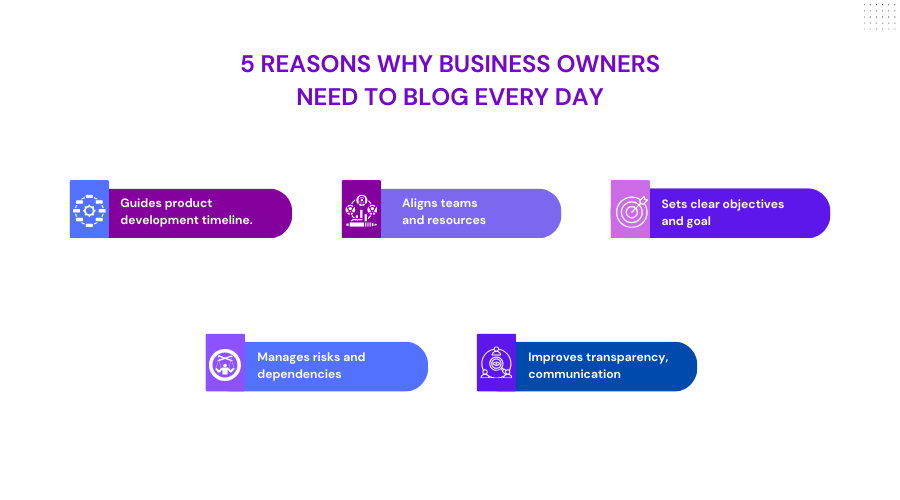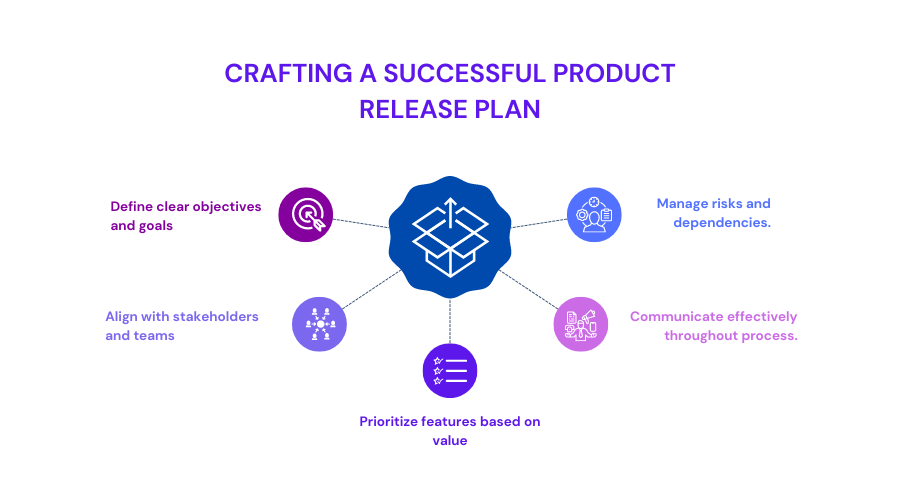How to Create Effective Product Release Plans?

Have you ever pulled an all-nighter to fix bugs before a vital product launch, only to discover more issues in the final hours? Have you received customer complaints about unexpected changes in your latest update?
Creating effective release plans is crucial for any product or software development team. But all too often, planning is an afterthought – you rush features out the door without properly considering stakeholder needs or our capacity. It leads to stress, disappointed users, and damaged reputations.
There must be a better way, right? How do successful companies set themselves up for release success every time? What elements should we focus on to develop a comprehensive yet flexible plan? And what tools can help optimize our process?
Most importantly, how can we prevent last-minute “fires” and ensure every new version delights rather than frustrates?

In this article, we aim to explore release planning best practices and provide actionable tips to develop effective strategies.
Product Release Plan and Its Role In Product Management
Having a well-thought-out product release plan is incredibly important for any product manager. It ensures the team is coordinated and working towards common goals. Release planning helps synchronize all the moving pieces necessary to successfully deliver a new feature or product update.
Without a clear plan, it’s easy for teams to get scattered or misaligned on timelines and priorities. The product manager loses visibility into dependencies and risks. A good release plan prevents these issues by establishing structure and shared understanding. It gives everyone a roadmap to follow throughout the development and launch process.
Release planning starts by defining what you want to achieve and when. It considers strategic direction, feature scope, engineering capacity, and timelines from other teams. Dependencies get identified, so nothing holds things up. This upfront work de-risks the entire schedule. It also allows estimating release dates realistically based on the work involved.
Read: Strategies To Manage Dependencies in Agile Teams
Once you make the plan, the product manager can smoothly guide the team with checkpoints and accountability. Any potential delays or blockers get spotted in advance. Stakeholders outside engineering stay informed through a shared roadmap. This coordination is key for having predictability in delivering value to users.
At the end of the day, release planning fosters better communication and team alignment. It helps product teams work as a well-oiled machine.
The manager can then focus on high-level strategic priorities rather than managing day-to-day chaos. Users benefit from a more organized process with on-time, high-quality releases. So, in summary, release plans are critical for product success.
Steps to Create a Successful Release Plan
- Define Clear Objectives and Features
- Evaluate and Streamline the Product Backlog
- Estimate Resources and Timelines for Release
- Plan Iterative Releases for Milestone Achievement
- Determine the Product Release Calendar
- Continuously Refine Plans Through Feedback
Step 1. Define Clear Objectives and Features
The foundation of any successful product release starts with establishing clear objectives. Taking the time upfront to define what you hope to achieve will guide all subsequent decisions and ensure your efforts focus on delivering real value.
You must facilitate discussions that bring diverse perspectives together around a shared vision. Start by interviewing key stakeholders – customers, sales team, developers – to understand perspectives on needed features and priorities. Look for common pain points or opportunities that could drive adoption if addressed.
With insights in hand, work with product owners to draft an initial vision statement. This high-level description captures the intended purpose and desired outcomes at a general level without specifying solutions. For example, “To become the most reliable CRM for small businesses by eliminating data errors.”
Read: How to Manage Product Releases and Versioning
Share the draft vision across teams to solicit feedback and identify any gaps. Iteratively refine it until all parties agree on the intended direction. Now, you have a North Star to help navigate priorities when challenges arise.
Break down the vision further by detailing specific objectives that will move the needle with measurable success criteria. For example, “Reduce data entry errors by 50% within six months of launch.” Communicate objectives widely so everyone understands their part.
Objectives will likely evolve as you learn more. Schedule regular reviews to reassess priorities against business needs and customer progress. A flexible vision keeps plans customer-centric.
Using Chisel, you can list and compare different features and components of your product, all in one place. It helps you get an overview of how each aspect contributes to your objectives. This top-notch product management tool lets you see the big picture and make informed decisions during the release planning phase.
Sign up for Chisel’s Free Forever Version here.
Step 2. Evaluate and Streamline the Product Backlog
Before embarking on a new software release, clarifying what tasks truly need to be accomplished is important. A bloated backlog of unclear or irrelevant items will only derail your progress. Taking time upfront to evaluate and prioritize is key to staying focused on outcomes that matter most.
Start by revisiting your product vision and goals for this release. Why are you building this functionality? What user needs are you addressing? Bring your agile team together for a backlog refinement session. Work through each item: does it align with your north star? Can it be traced back to specific user stories? If not, it may be time to retire it from the backlog.
When an item passes the relevance test, define it in user-centered terms. User stories help ensure you design for real human needs rather than technical tasks. Estimating stories at this stage also gives insight into your capacity. Look for logical groupings of stories that represent minimum viable features.
Input from stakeholders outside development is invaluable here, too. Discuss priorities from their perspectives to balance internal technical efforts with external business drivers. Prioritization criteria like business value, risk reduction, and dependency help determine the release sequence.
Once sorted, document your backlog in a Scrum board or project management tool. It sets the stage for productive sprint planning and keeps everyone aligned on objectives. Review and refine ongoing for recurring releases to incorporate new requirements or opportunities identified.
Chisel’s Treeview tool and RICE prioritization framework work together to provide a structured and visual way to assess and prioritize items in the product backlog. It helps teams decide what features to prioritize for the upcoming release, ensuring that development efforts get focused on delivering the most impactful and valuable outcomes.
Sign up for Chisel’s Free Forever Version here.
Step 3. Estimate Resources and Timelines for Release
After finalizing your product vision and prioritizing features, it’s time to get stakeholders together for a release planning session. The goal is to ensure everyone understands the strategic direction and can collaborate effectively to reach it.
The meeting provides an opportunity to review progress engagingly. You’ll want to spark discussion and gather diverse perspectives to refine your plans. Presenting information visually and then opening the floor for questions and ideas helps foster real understanding among attendees.
A typical agenda might include:
- Reviewing the Roadmap: Revisit your high-level product goals to confirm comprehension and buy-in. It gets everyone aligned on what you’re building and why.
- Inspecting the Architecture: Discuss technical details and any new considerations impacting estimates. Address dependencies, assumptions, or knowledge gaps proactively.
- Estimating Velocity and Iterations: Share your projected team pace based on prior experience. Outline a development cycle, distributing work reasonably across sprints.
- Defining “Done”: Collaboratively set acceptance standards. When can a feature be considered complete? Clear guidelines help teams and stakeholders stay synchronized.
For example, you can review upcoming authentication improvements at your planning session.
By visualizing planned vs. estimated work, you have adjusted timelines to incorporate additional integrations important to key clients. Defining “Done” will help you ensure security and usability and make sure you meet documentation standards to the client’s satisfaction.
Chisel’s Kanban View and Timeline View enhance release planning by providing a dynamic, real-time, and strategic perspective on feature development. It aids in estimating resources, adjusting timelines, and fostering effective collaboration among stakeholders and the development team.
Sign up for Chisel’s Free Forever Version here.
Step 4. Plan Iterative Releases for Milestone Achievement
When tackling a large product release, it’s easy to get overwhelmed thinking about all the work needed. That’s why iterative development through sprint planning is so effective. Rather than viewing your release as one massive mountain to climb, break it down into smaller, more manageable goals.
Think of each sprint as putting one foot in front of the other. By completing sprints, you’ll steadily progress toward the overall release. This incremental approach prevents analysis paralysis and motivates the team by achieving min-victories.
When determining your sprint timeline, look at your team’s average velocity – how much work they can reasonably complete within a set period, usually one to four weeks. Use past sprints as a guide for estimating future work. Strive for sprints that are neither overly ambitious nor lacking in substance.
Give each sprint a clear, narrowly defined scope for addressing specific features or bugs. At the end of each sprint, those items should get finished and tested so progress is demonstrable. Carry unfinished work to the next sprint backlog rather than overloading.
Communicate your sprint roadmap openly with stakeholders so everyone understands the step-by-step nature of iterative development. Update timelines if needed, but avoid scope creep pressuring sprints to take on too much.
Chisel’s Release View aids in practically implementing the iterative development approach by providing a structured and visual way to organize, plan, and execute smaller, manageable goals within each release cycle. This, in turn, helps achieve the larger milestone of a product release without feeling overwhelmed by its magnitude.
Sign up for Chisel’s Free Forever Version here.
Step 5. Determine the Product Release Calendar
Now that the planning meeting is complete and you have finalized all details, it’s time to share the product release calendar with stakeholders.
Everyone involved should have ongoing access to the release plan for easy reference and updates. A clearly defined Scrum release plan will help the team focus on completing the right tasks at the right time.
Creating a thoughtful and accessible release plan is important because it directly impacts the project’s future success. Use a visual workspace like Chisel to craft release plans that are informative, clear, and easy for all stakeholders to understand at a glance.
With a tools like Release View, Kanban View and more by Chisel, managers, team members, and other stakeholders can view project plans and timelines in real-time, ensuring nothing falls through the cracks.
Sign up for Chisel’s Free Forever Version here.
The entire team must have access to the finished release plan. As the project manager or scrum master, you’ll use the plan to keep everyone on track with the right assignments based on schedule.
For example, let us say a company is releasing its new customer relationship management (CRM) software in batches over the next six months. They’ve mapped out which features will launch each monthly update, identified dependencies between releases, and assigned responsibilities and deadlines.
The development, QA, and support teams can seamlessly work toward scheduled launch dates by publishing their detailed release calendar. At the same time, stakeholders get complete visibility into progress. Transparent planning in this way helps the CRM software meet its milestones on time and budget.
Step 6. Continuously Refine Plans Through Feedback
While creating a thorough release plan is essential for staying on track, it’s also crucial to remain flexible and adjust based on feedback. No plan will work perfectly from the beginning, so be ready to refine yours over time based on how the work actually progresses.
Listen to feedback from team members and stakeholders to understand where modifications would be helpful. Things like customer needs, competitive landscape changes, shifts in business goals, or technical setbacks may necessitate adjustments. Be willing to update timelines and responsibilities as needed to ensure smooth execution.
This iterative approach is core to agile methodology. Your release plan is a work in progress, not a rigid schedule to follow at all costs. As you continue implementing, leverage agility to tweak plans based on learnings. Don’t just release for the sake of releasing. Use each cycle to gather feedback and continuously improve your process.
For example, let us say a company released the initial version of their new accounting software and surveyed customers on the experience. Users provided feedback on confusing workflows and missing functionality.
In response, the product manager updated the release plan to prioritize fixes for the next sprint based directly on customer input. Taking the time to refine plans with each release ensures the software better serves users over time.
Consistency is also important. Create a standardized release template to guide planning and document evolving best practices. Continue assessing velocity and adjusting workflows with every sprint. agile planning is an ongoing process of learning and enhancing plans to maximize quality and success.
Chisel’s Product Feedback tools facilitate a dynamic feedback loop that supports the iterative nature of release planning. They enable you to not only adjust the current plan based on real-time insights but also to integrate a feedback-driven approach into future planning, enhancing the product’s alignment with customer needs and expectations over time.
Sign up for Chisel’s Free Forever Version here.

Key Takeaways
Creating effective product release plans is crucial but not always straightforward. Juggling stakeholder needs, development cycles, and market demands requires forethought and coordination. In this article, we provided a framework for structuring your release planning process through roadmapping, feature prioritization, and sprint planning.
By defining your product vision and breaking it into achievable milestones, you establish direction and motivation. Prioritizing features based on value and effort ensures you’re delivering the most worthwhile capabilities first. Building releases through timeboxed sprints with well-defined scopes and goals keeps progress measurable and on track.
If ensuring the right features launch smoothly and on schedule is important for your product’s success, we highly recommend exploring Chisel’s release management tools.
Read: 10 Best Release Management Tools for Every Budget
Chisel’s Kanban-style boards and automated workflows streamline all aspects of release planning covered here. Its visibility into tasks, dependencies, and resource allocation helps mitigate risks to stay compliant with your roadmap.
Click here to see Chisel in action. With a free trial as well as free forever version, you can experience how it streamlines coordination, flagging issues early. Following the best practices we discussed with Chisel’s support will allow you to execute release plans that exceed customer expectations every time.
